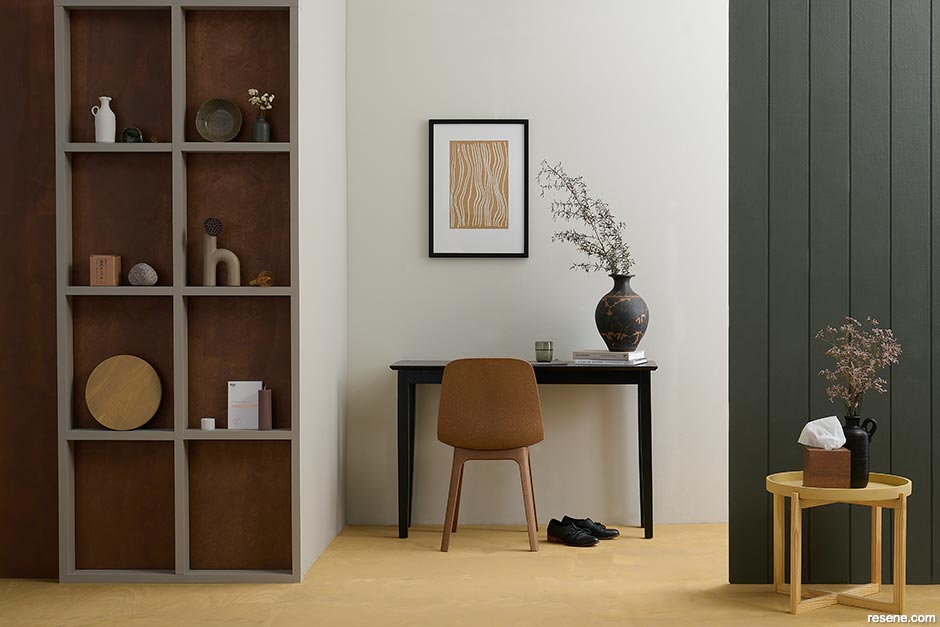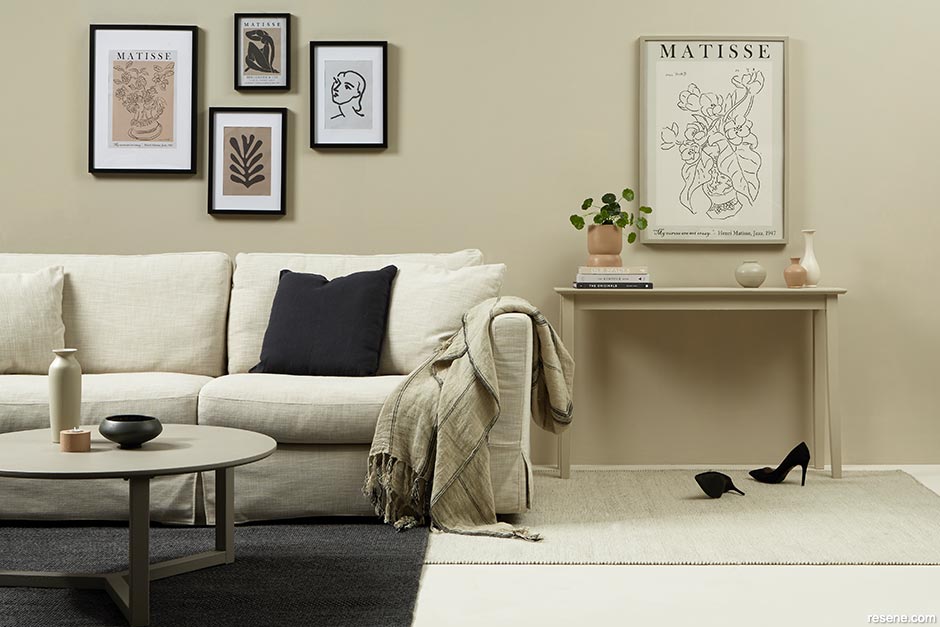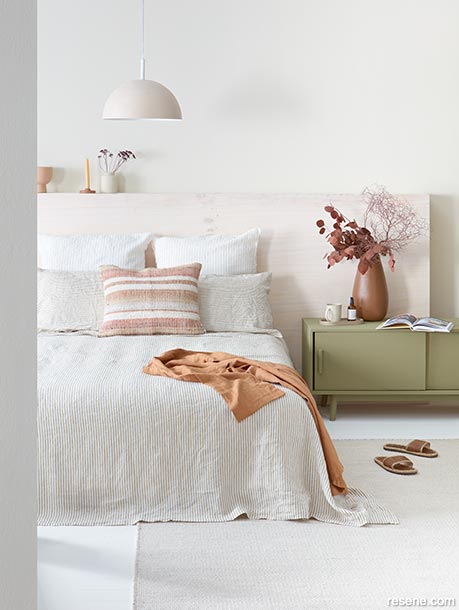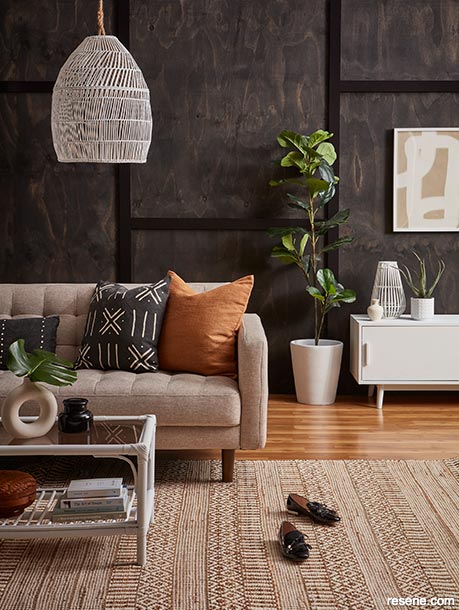From the Resene decorating blog
Serene, balanced and organic… these are a few words that sum up Japandi style, which has been turning more and more heads over recent years.
It's no surprise why it has garnered attention. Japandi marries the nurturing elements of Japanese and Scandinavian aesthetics, creating a look that celebrates warm minimalism, organic materials and simplicity.

Relaxing neutrals and warm earthy tones strike a balance with the fresh white in this office space. It’s a calm, serene Japandi setting full of character, which is just what you want in a work or study area. The repetition of the vertical lines in the wall panels, frame, desk leg and bookshelf bring unity, while the fluid forms of the décor objects, side table and vases ensure a visual softness.
Back wall painted in Resene Triple Merino, timber wall (left) stained in Resene Colorwood Pickled Bean, tongue-and-groove wall (right) in Resene Quarter Karaka, batten shelf in Resene Settlement, plywood floor stained in Resene Colorwood Uluru, desk in Resene Enamacryl gloss tinted to Resene All Black, chair in Resene Anglaise, tissue box stained in Resene Colorwood Pickled Bean, large jug vase in Resene Nero, vase painted Resene Karaka, small jug vase (top left shelf) in Resene Half Blanc and tray table in Resene Teak. Artwork by Home Time from endemic world, chair from Urban Sales, glass from Flo and Frankie Home, tissue box from Citta, plate from Freedom. Project by Kate Alexander, image by Bryce Carleton.
Break Japandi down and among its ingredients you'll find inspiration in the Scandinavian concept of hygge, which encourages us to find comfort in daily life. When it comes to interiors, hygge refers to iconic Scandi features, such as cosy sheepskin rugs, pale wood, free-flowing minimalist spaces and curling up by the fire – elements that warm the soul.
You'll also discover aspects of Japanese design that veer towards richly coloured wood, balance and order, as well as a connection with nature.
As well as embracing wellbeing and living comfortably, Japanese and Scandinavian designs also share a celebration of craftsmanship – this you’ll also find in Japandi decor.
With all these elements of nurture combined, Japandi brings a little zen into our busy lives. With more of us putting sustainability at the forefront of our minds, an aesthetic that adopts simplicity and nature as a solution to throwaway culture almost feels like medicine.

Clean lines are a prominent feature of Japandi style. The rectangular shapes of the sofa, console and frames provide harmony in this room. The round coffee table offsets this rigidity perfectly. Organic and comforting, the colours are inspired by nature, the dark accent balancing them with its contrast.
Wall painted in Resene Tea, floor in Resene Blanc, coffee table in Resene Half Sandstone, plinth plant pot (on coffee table), tealight holder in Resene Sandal, console table in Resene Bison Hide, small vase and large frame in Resene Tapa and other vases in Resene Sandal and Resene Quarter Drought. Artwork from Etsy, sofa from Freedom, cushion from H&M, throw from Adairs, rugs from Città. Project by Vanessa Nouwens, image by Bryce Carleton.
So how can we make our homes Japandi havens? Paint is an easy, effective way to do so. The fundamental tenet is to adopt a colour palette that is understated, calm and inspired by nature. Think earthy tones, warm greys and neutrals, with your lighter tones being the commanding colours. Layer these varying tones to provide depth to your space. Accompany with dark paint accent features too, as these will bring a contrasting effect. By combining the dark walnut or charcoal colours of Japanese design with the blonde wood of Scandi décor, you'll achieve pockets of contrasts throughout your home that feel interesting yet balanced.
Resene Colour Consultant Amy Watkins recommends using certain warm earthy colour tones. "The main neutrals used in the Japandi aesthetic are Resene Rice Cake, a sharp, clean edge yellow-white, Resene Merino, a versatile off-white with a green oxide undertone and Resene Quarter Tea, a muted soft complex beige," she says.
"For bolder feature colours or colours used in soft furnishings, use Resene Paddock, an unusual wistful green, Resene Coral Tree, a soft dusty coral red and Resene Clay Creek, a sand beige," she says.
For added interest, there are other options to pair your colours with. "The Japandi look is all about reflecting the light and bright earthly hues while using clear and clean lines," Amy says. "As the Japandi style is all about reflecting the natural environment, the lighter shades of your off-whites best help to give you clean lines against the natural timbers that are often used in this design aesthetic. These whites are Resene Rice Cake, Resene Merino and Resene Quarter Tea."

Evoke the peace and restoration that we enjoy in nature with dried flowers or twigs, painting them to blend in with your colour scheme. A simple warm white base invites a layer of welcoming soft blush, a few tones lighter than the plants and the vase in which they sit.
Wall painted in Resene Triple Pearl Lusta, timber headboard finished in Resene Colorwood Whitewash, left wall in Resene Half Pearl Lusta, floor in Resene Eighth Pearl Lusta, props in Resene Triple Bison Hide, Resene Half Bison Hide, Resene Grey Olive, Resene Sour Dough, Resene Alamo, Resene Brown Bramble, Resene Hemlock. Candle and holder, dressing gown, mug, body oil, book, throw and house slides from Blackbird Goods, bedlinen from Foxtrot Home, cushion, rug, small pink marble vase and pink cushion from Citta, tray and book from Paper Plane. Project by Gem Adams, image by Wendy Fenwick.

The Resene Colorwood stain on this lounge wall allows the natural grain to show through, providing texture and visual interest. Dark battens provide precision to the space, their linear forms echoed in the sideboard and sofa.
Plywood wall stained in Resene Colorwood Sheer Black with battens painted in Resene Lustacryl tinted to Resene All Black, floor in Resene Colorwood Natural, sideboard in Resene Snow Drift, coffee table in Resene Snow Drift, pillar in Resene Black White, pendant lamp in Resene Black White, plant pots in Resene Snow Drift, tall woven candle lantern in Resene Half Black White, small fluted bud vase (on coffee table) in Resene Quarter Drought and artwork in Resene Okey Dokey (background) with strokes in Resene Half Blanc. Sofa from Nood, rug from Adairs, cushion covers from Citta, artwork by Cloud 9 Creative (Lee Sinclair) from endemicworld, shoes from H&M. Project by Laura Lynn Johnston, image by Wendy Fenwick.
When it comes to painting dark accents, inky Resene Jaguar and smoky Resene Ironsand will resonate deeply within your space. Apply to a dining table, surrounded by chairs in pale or warm wooden tones on a pale wood floor with a cosy rug nearby. Or your kitchen may feature crisp white walls with cabinetry in stained timber tones – paint your island in dark black for effect, throwing in some greenery for a softening impact.
Or layer tones of colour and texture through freestanding furniture, such as dining chairs or an occasion chair in charcoal or dark walnut wood. Nearby, a dining table or cabinet in pale wood would provide the tonal contrast. You can rejuvenate the colour of timber with Resene Colorwood interior wood stain for a lighter or darker finish that still allows the timber grain to show through.
Paint your front door in black, with surrounding white exterior walls. Or coat some or all of your internal door frames in charcoal, emphasising precise lines with dark contrasts.
What materials or fabrics work well with these Japandi paint colours? Bring in organic tactility and minimal forms. "Natural materials, such as timber, are the biggest influence in this design, for instance, light oak,” Amy says. “Adopt plants to help introduce pops of colour without overstating the area.”
“The most important thing is to declutter the space when following the Japandi design and keep within the warm colour palettes with colours such as Resene Bianca, Resene Quarter Albescent White and Resene Half Thorndon Cream.”
Your aim with achieving Japandi style is to keep your setting serene and restful. Clear out any clutter, creating a minimal, relaxed-looking space. Think flow. A home with clean lines that feel easy to move around will be enjoyable and pleasant for its inhabitants. A cluttered rabbit-warren may not. This might mean culling your items every few months, throwing out what you don't need or want, freeing up space and allowing for easy living. Many of us can thank Japanese consultant Marie Kondo for her help in this department. If you haven't used an item or worn an outfit in the past year, maybe it's time to give it away?
Other key elements that appeal include texture, so bring in sheepskin and sisal rugs, linen upholstery, rattan furniture accompanied by plants in baskets and vases and décor in fluid shapes. You don't want your room too symmetrical and perfect, remember – Japandi is all about embracing the beauty in imperfections. Your space shouldn’t feel too crowded with objects either, in true Japandi fashion. Instead, keep your spaces visually clean and minimal.
Ultimately, it’s the fact that Japandi puts mental wellbeing at the highest importance that makes it so appealing. Comfort is prioritised, through paint colours that have a positive effect on our emotions and senses. By tuning in to nature and order when selecting our hues, we're allowing ourselves to relax and stay in line with the natural movements of each day. It’s all thanks to an effortlessly calm setting. “The warm, inviting natural aspect of the undertones, as well as lighter colour shades hold their own in an interior,” Amy says. “Because the Japandi aesthetic focuses on the simplicity of design, it really allows the soft colours to come into their own and reflect the architecture of the space.”
September 31, 2021
Visit your local Resene ColorShop for expert advice and all the products and accessories you need to make the most of your home.
Book a colour consult | Ask a Colour Expert | Ask a Paint Expert
Resene's decorating blog
Paint your home beautiful! Discover the latest decorating trends, tips and colour news.
![]()
Previous «
Shape shiters
![]()
Blog home
View the latest trends, tips and news
![]()
» Next
Colour psychology for your home office: paint yourself productive